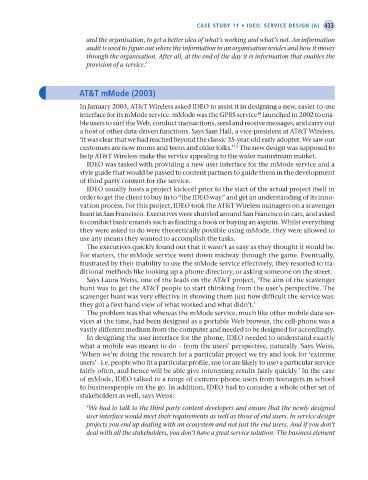Page 458 - Operations Strategy
P. 458
case study 11 • IdeO: servIce desIgn (a) 433
and the organisation, to get a better idea of what’s working and what’s not. An information
audit is used to figure out where the information in an organisation resides and how it moves
through the organisation. After all, at the end of the day it is information that enables the
provision of a service.’
AT&T mMode (2003)
In January 2003, AT&T Wireless asked IDEO to assist it in designing a new, easier-to-use
interface for its mMode service. mMode was the GPRS service launched in 2002 to ena-
14
ble users to surf the Web, conduct transactions, send and receive messages, and carry out
a host of other data-driven functions. Says Sam Hall, a vice-president at AT&T Wireless,
‘It was clear that we had reached beyond the classic 35-year-old early adopter. We saw our
15
customers are now moms and teens and older folks.’ The new design was supposed to
help AT&T Wireless make the service appealing to the wider mainstream market.
IDEO was tasked with providing a new user interface for the mMode service and a
style guide that would be passed to content partners to guide them in the development
of third party content for the service.
IDEO usually hosts a project kick-off prior to the start of the actual project itself in
order to get the client to buy in to “the IDEO way” and get an understanding of its inno-
vation process. For this project, IDEO took the AT&T Wireless managers on a scavenger
hunt in San Francisco. Executives were shuttled around San Francisco in cars, and asked
to conduct basic errands such as finding a book or buying an aspirin. Whilst everything
they were asked to do were theoretically possible using mMode, they were allowed to
use any means they wanted to accomplish the tasks.
The executives quickly found out that it wasn’t as easy as they thought it would be.
For starters, the mMode service went down midway through the game. Eventually,
frustrated by their inability to use the mMode service effectively, they resorted to tra-
ditional methods like looking up a phone directory, or asking someone on the street.
Says Laura Weiss, one of the leads on the AT&T project, ‘The aim of the scavenger
hunt was to get the AT&T people to start thinking from the user’s perspective. The
scavenger hunt was very effective in showing them just how difficult the service was:
they got a first hand view of what worked and what didn’t.’
The problem was that whereas the mMode service, much like other mobile data ser-
vices at the time, had been designed as a portable Web browser, the cell-phone was a
vastly different medium from the computer and needed to be designed for accordingly.
In designing the user interface for the phone, IDEO needed to understand exactly
what a mobile was meant to do – from the users’ perspective, naturally. Says Weiss,
‘When we’re doing the research for a particular project we try and look for ‘extreme
users’ - i.e. people who fit a particular profile, use (or are likely to use) a particular service
fairly often, and hence will be able give interesting results fairly quickly.’ In the case
of mMode, IDEO talked to a range of extreme phone users from teenagers in school
to businesspeople on the go. In addition, IDEO had to consider a whole other set of
stakeholders as well, says Weiss:
‘We had to talk to the third party content developers and ensure that the newly designed
user interface would meet their requirements as well as those of end users. In service design
projects you end up dealing with an ecosystem and not just the end users. And if you don’t
deal with all the stakeholders, you don’t have a great service solution. The business element
Z11 Operations Strategy 62492.indd 433 02/03/2017 13:55

